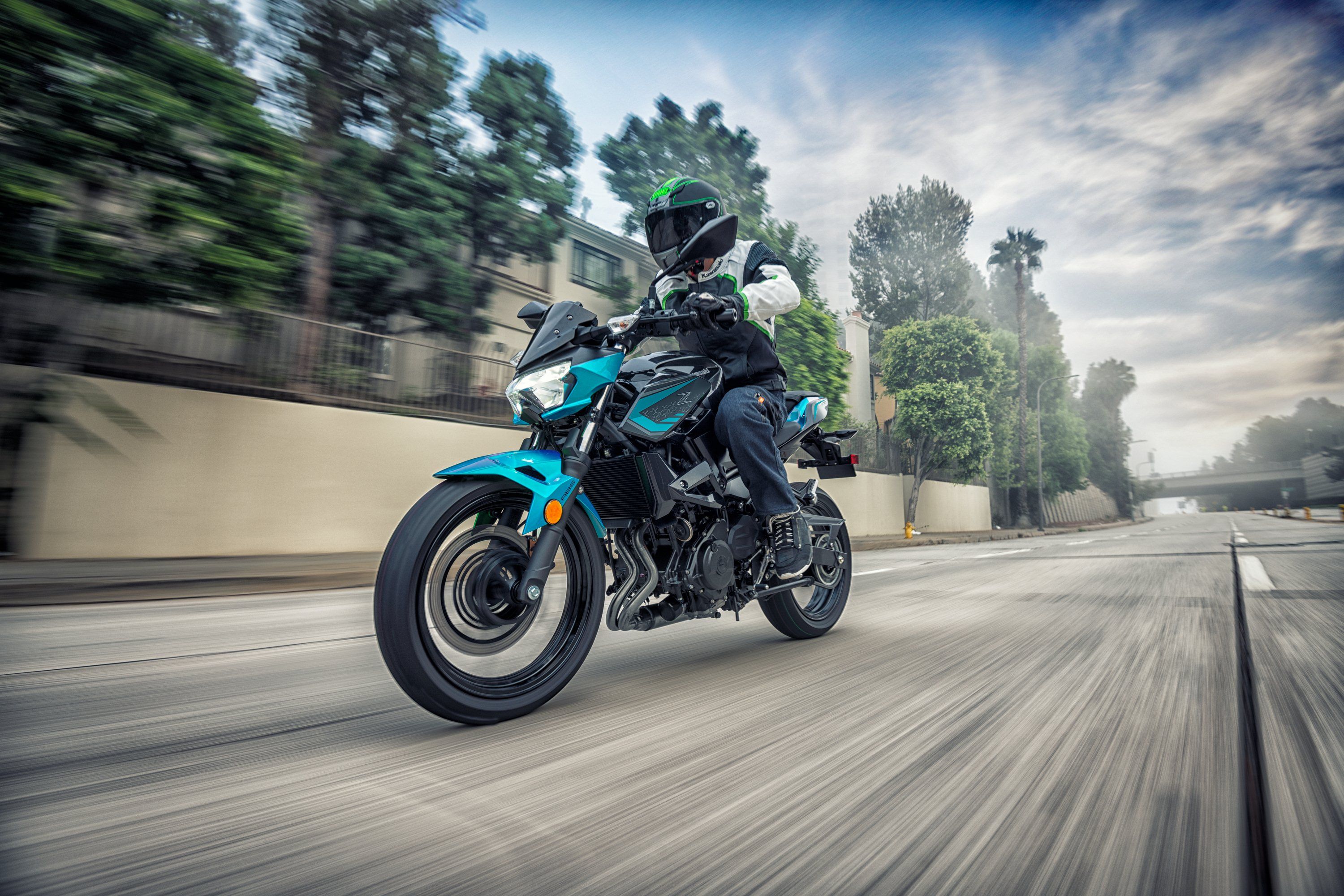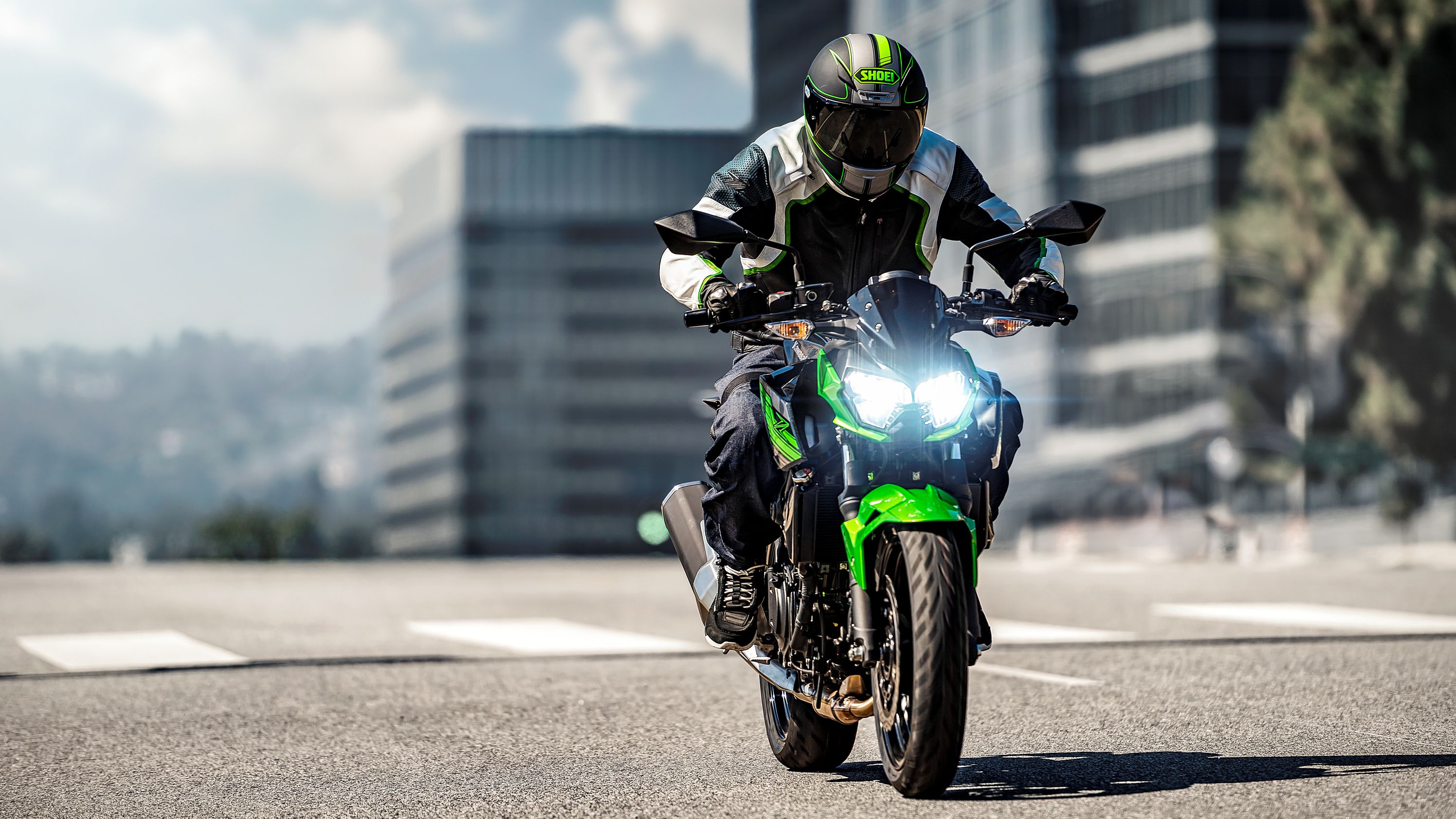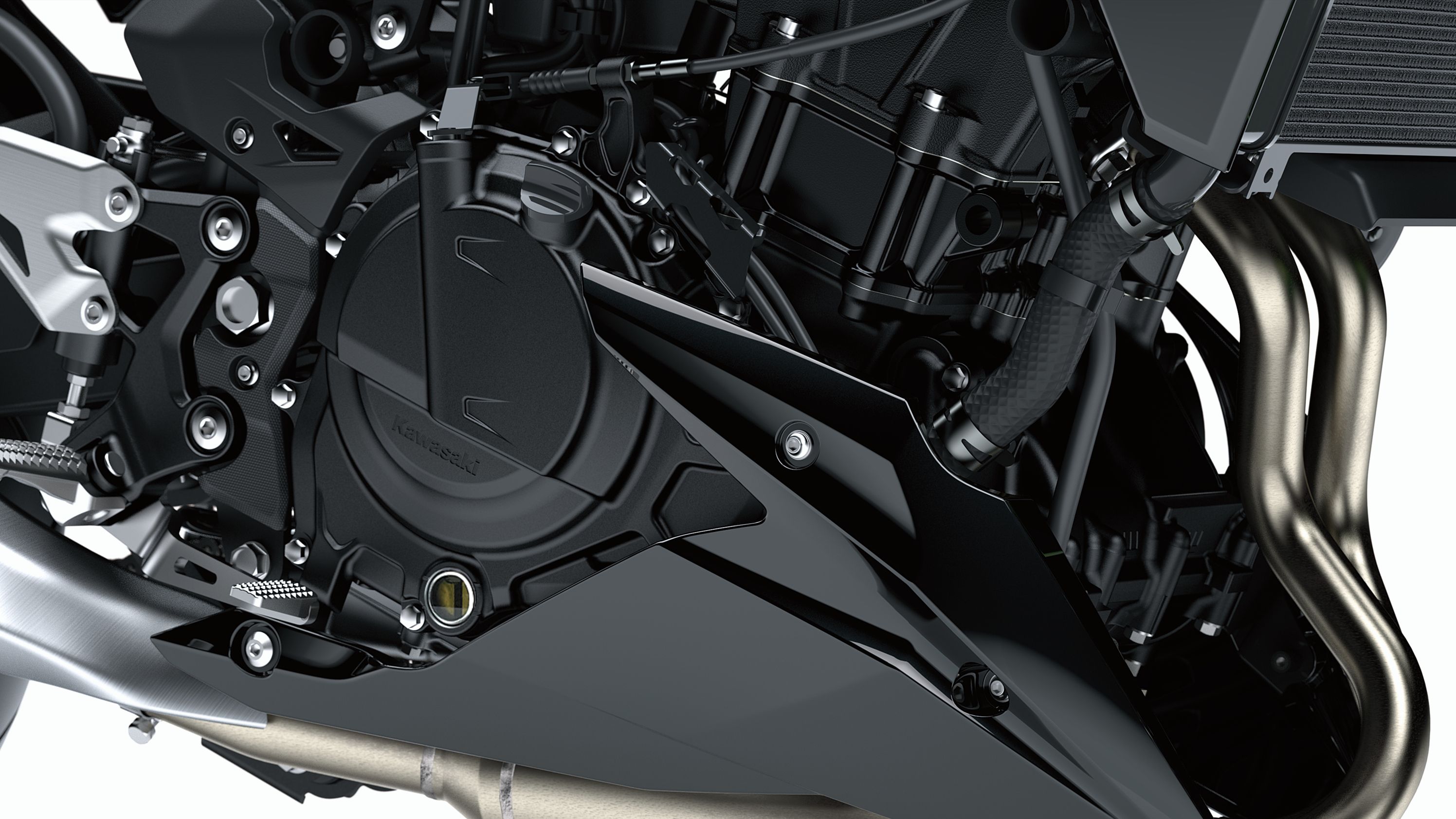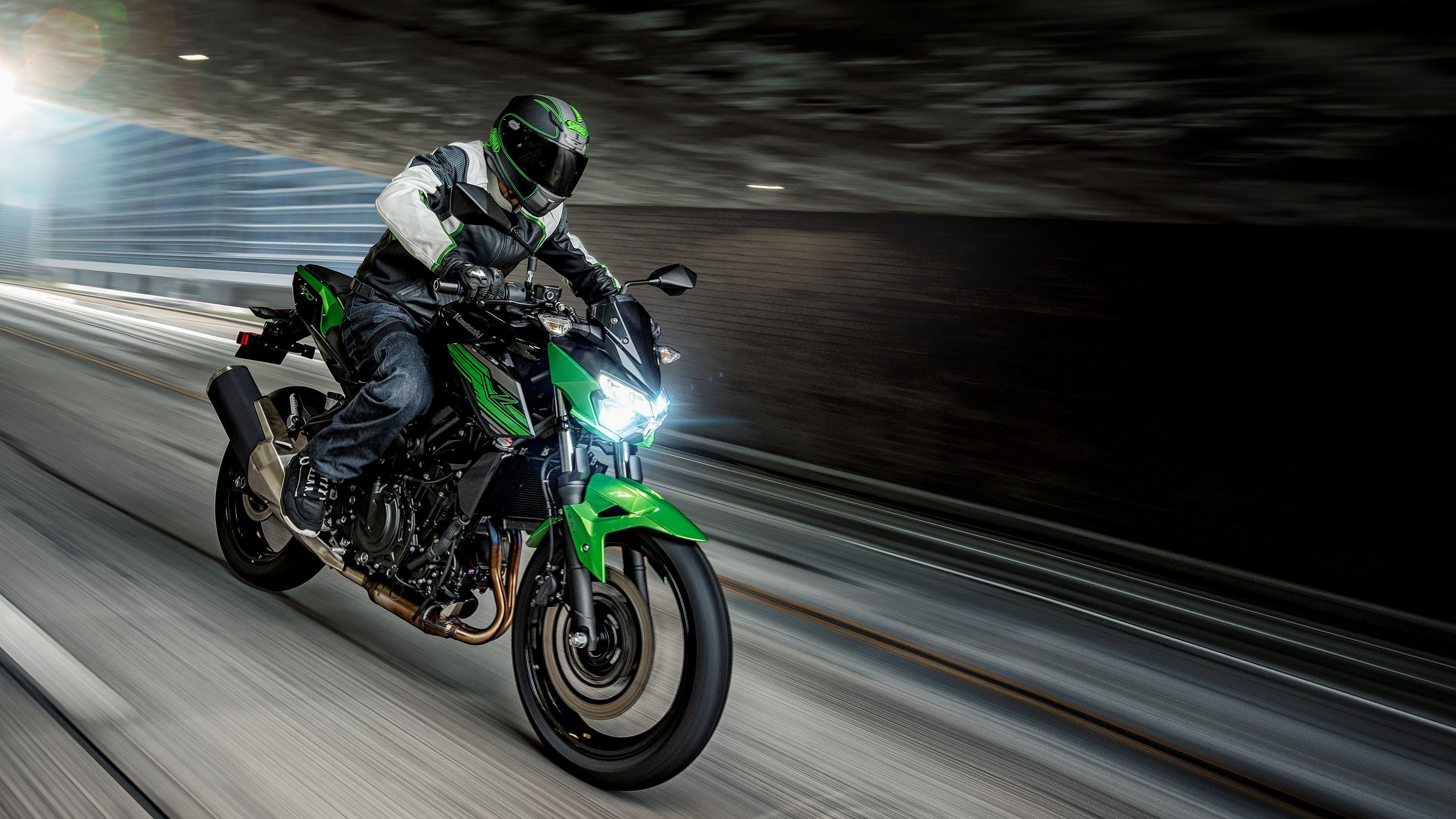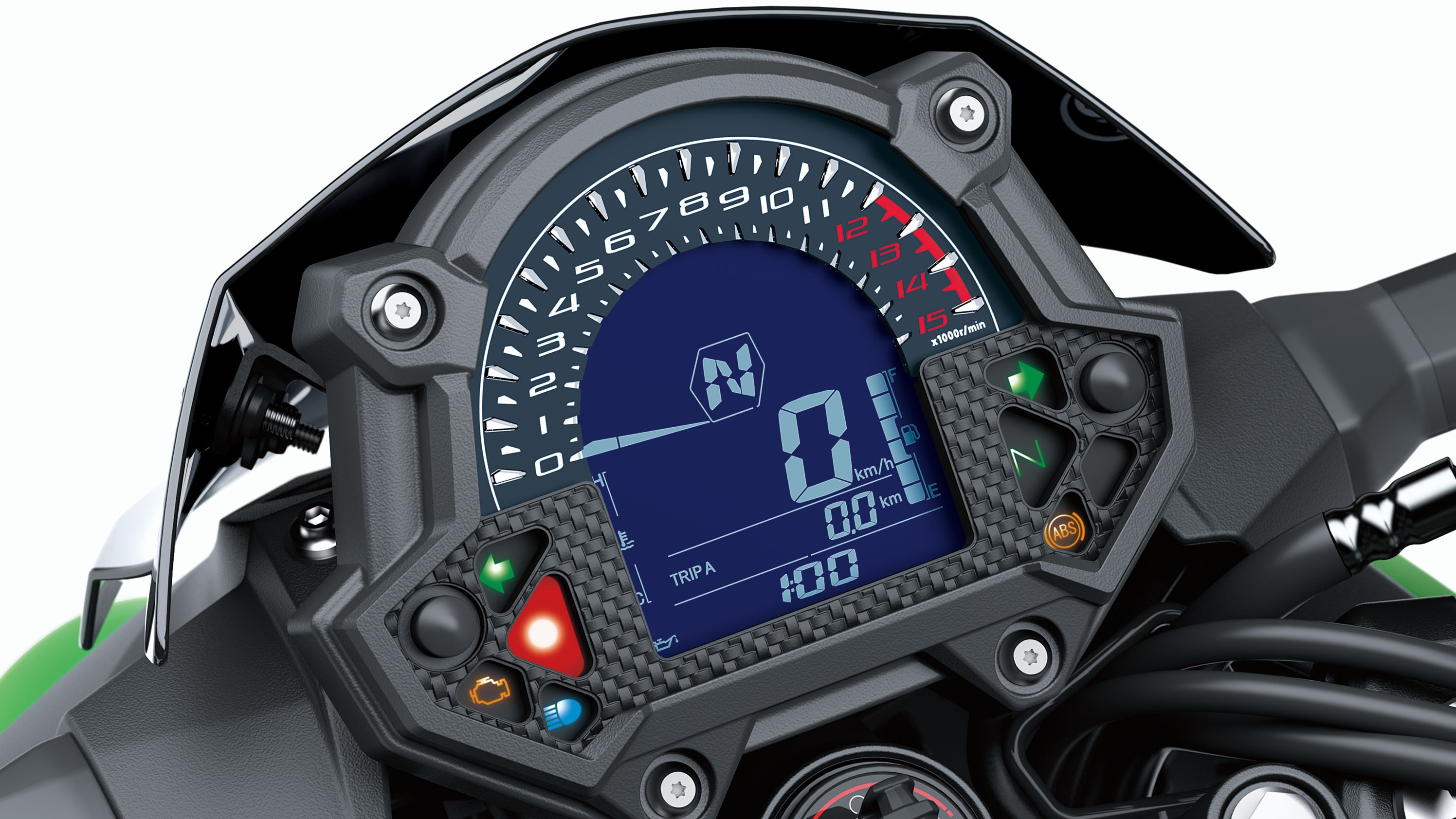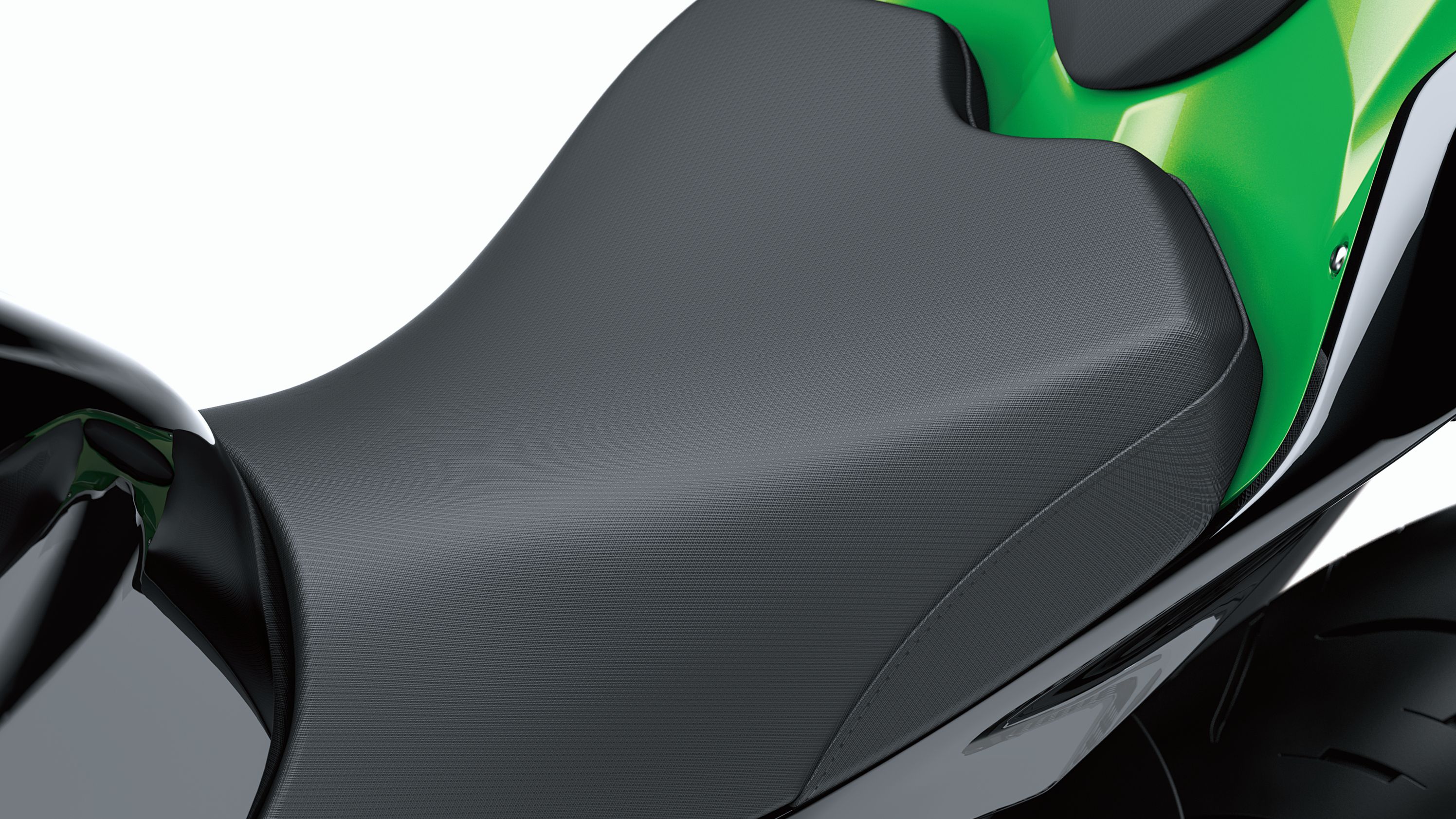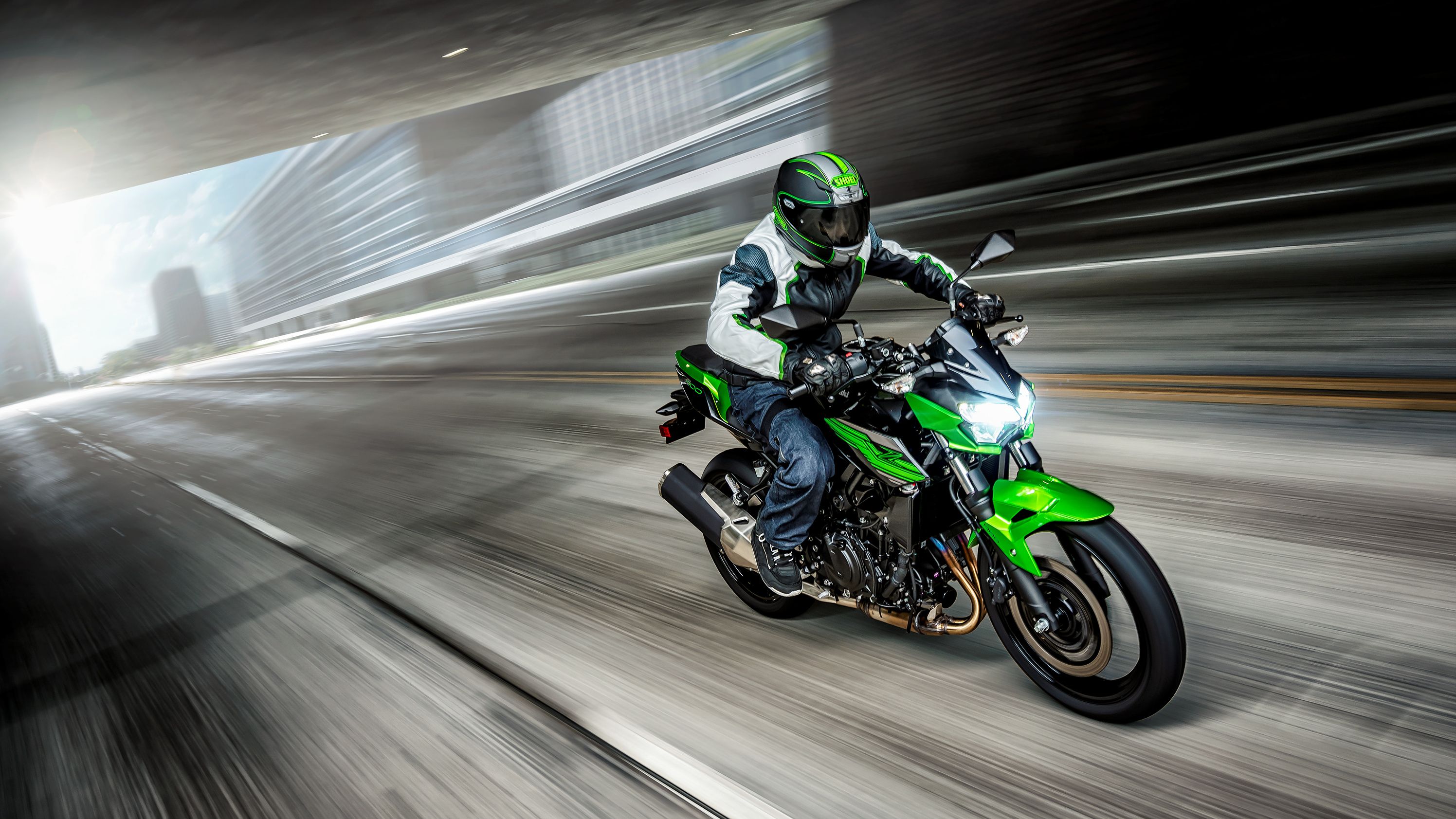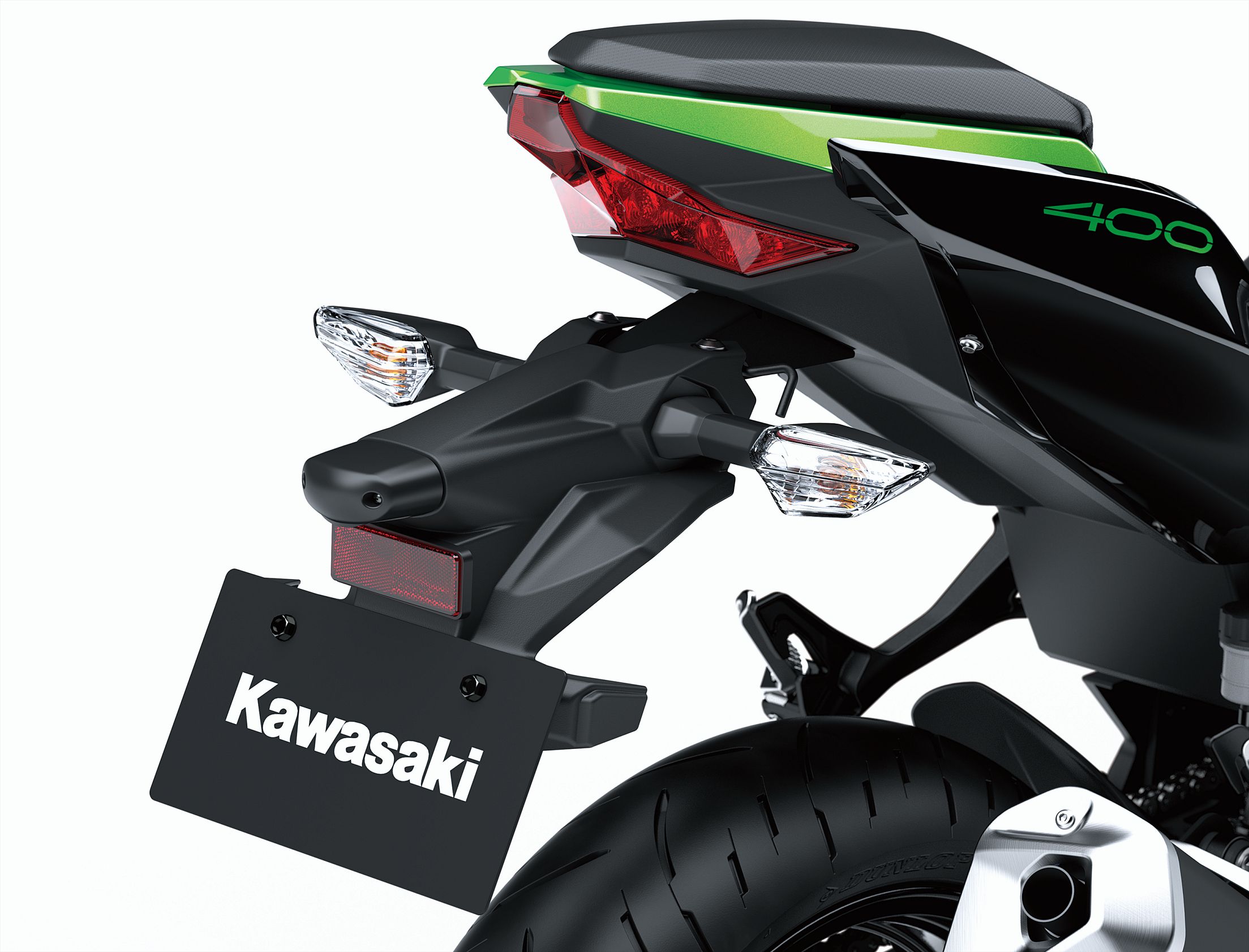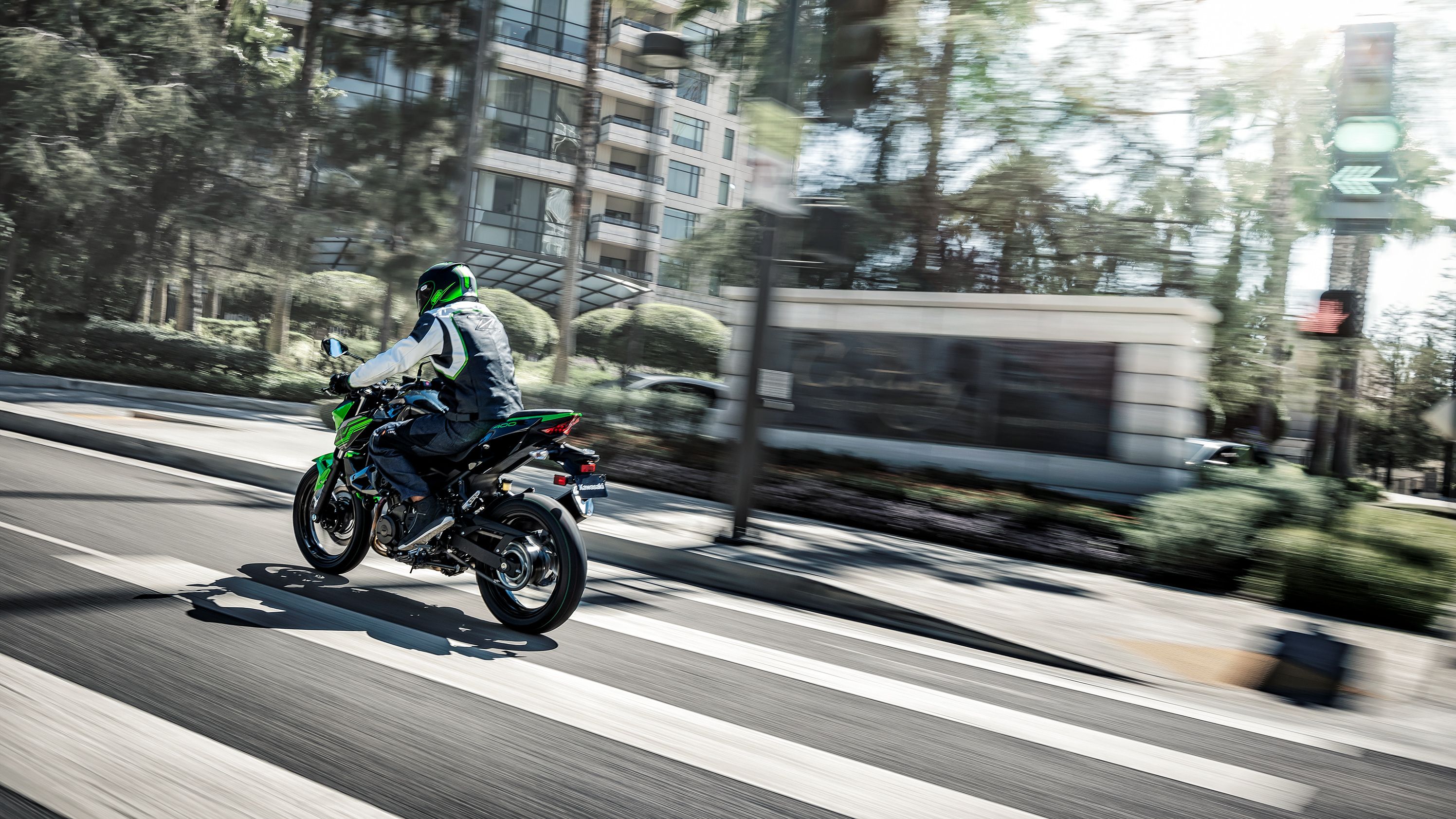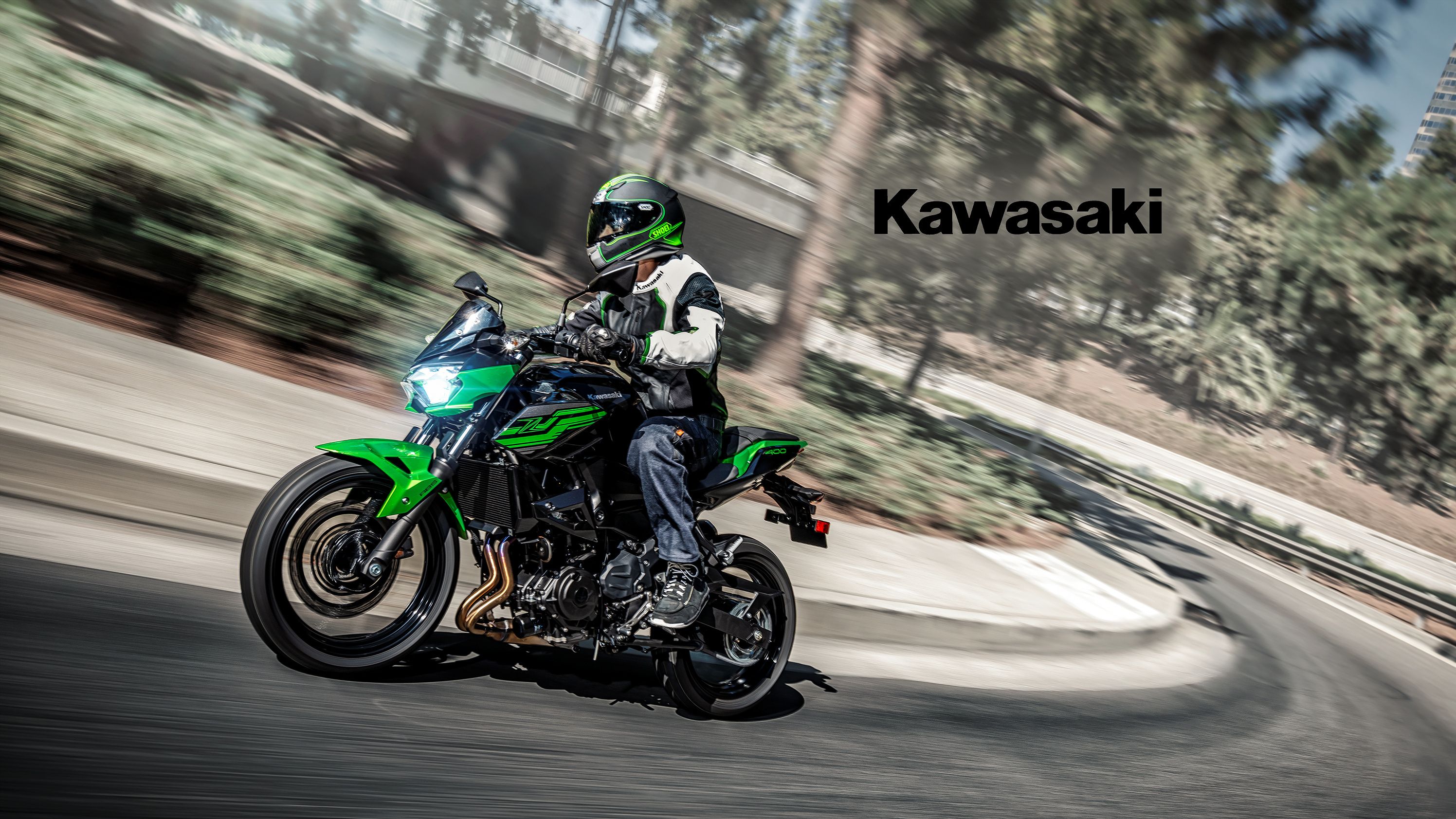Kawasaki needed to plug a hole in its super-naked lineup between the Z300 and the Z650, so it cooked up the new Z400 ABS to do the job. Aggressive Kawi styling dominates the look, but not necessarily the attitude, to make the Z400 an excellent commuter/first upgrade from whatever you cut your teeth on. The ergonomics are friendly to shorter inseams and conducive to relaxed riding, so this is a bike that should cover a range of body types.
2019 - 2022 Kawasaki Z400 Performance and Capability
Kawi pulled the liquid-cooled, 399 cc engine over from its Ninja supersport division. It rocks a pair of 70 mm bores in a parallel-twin configuration with a 51.8 mm stroke and 11.5-to-one compression ratio that will put you at the premium hook to keep it from knocking/pinging/dieseling.
This powerplant is pretty raw in the sense that it doesn't come with much in the way of electronic fandanglery. Sure, it uses a downdraft intake with 32 mm, electronic fuel-injection throttle bodies to manage the induction and a fancy digital timing-advance feature, but the suite has nothing in the way of rider modes, anti-wheelie, or traction control on board.
A slipper clutch does provide some extra security by preventing loss of traction due to excessive back-torque on hard downshifts and aggressive engine-braking techniques. That ain't quite the same thing as a proper set of safety electronics.
What does all this give us? Well, if you wind it up to eight grand you'll unleash 28 pound-feet of torque, and at an even 10 grand you can expect 44.7-horsepower with a curb weight of only 363.8 pounds so you can expect to have a little fun when you get twisty with that right grip. Power flows through a six-speed transmission and heads to the rear wheel via chain drive. Kawasaki Z400's top speed comes at about 112 mph.
|
Engine & Drivetrain |
|
|
Engine: |
4-stroke, 2-cylinder, DOHC, liquid-cooled |
|
Displacement: |
399 cc |
|
Bore x Stroke: |
70.0 mm x 51.8 mm |
|
Compression Ratio: |
11.5:1 |
|
Maximum Torque: |
28.0 lb-ft @ 8,000 rpm |
|
Fuel System: |
DFI® with 32 mm throttle bodies |
|
Ignition: |
TCBI with digital advance |
|
Transmission: |
6-speed, return shift |
|
Final Drive: |
Sealed chain |
Design
The Z400 manages to convey it's Kawi-ness through minimal body coverings that leave little to the imagination. It starts off right out of the gate with a cut-down/cut-out front fender that sets the stage for the spiky, aggressive design features to come.
The headlight housing is typical of the genre with dual LED projectors below a small flyscreen that protects the instrument can, but little else. As for the instrumentation, it sports an all-digital cluster that delivers an analog-style tachometer readout with a block-numeral display for speed and a gear indicator. There's a digital odometer and a trip meter, and a handful of idiot lights split between two clusters to take care of the rest.
The cheek fairings are probably the only superfluous body details. They seem to have little value beyond their aesthetic contribution 'cause they fall short of even covering the radiator kinda like high-waters britches don't cover your ankles. The radiator rides on the downtubes just above their union with the engine where it can breathe freely of the air coming over the top of the front fender.
The handlebar has a little rise to it, and since the overall size is fairly compact, it's sufficient to push your hands back enough to allow for a fairly-upright riding posture when you want to and there's room to tuck in when you need to.
A 3.7-gallon fuel tank comes to a peak about midway, and it carries a declining line all the way back to the saddle to give your upper torso some room when you go into your racing tuck. As you'd expect, the tank has a complex shape that uses an upper flange to fair out the airflow and form the knee pockets that pull your legs in out of the slipstream while tapering down in the back to the teeny-tiny waist.
A heavily-beveled saddle does its bit to give your legs room to reach the ground unimpeded when it's time to deploy your training wheels. The rise to the pillion forms a butt-bucket for the pilot and gives the Z400 an aggressive nose-down/tail-up sugomi style that shows its common DNA with the rest of the naked “Z” line and it puts the rider “in” the bike more than “on” it.
Fold-up, subframe-mount footpegs round out the passenger's gear, though the p-pad itself is less-than-generous with enough area to pad your passenger's tailbone and naughty bits but little else. The taillight rides tucked up under the tip of the tail with a stubby mudguard that props up the standoff turn signals and license plate to finish up the gear in the rear.
|
Dimensions & Capacities: |
|
|
Overall Length: |
78.3 in |
|
Overall Width: |
31.5 in |
|
Overall Height: |
41.5 in |
|
Ground Clearance: |
5.7 in |
|
Seat Height: |
30.9 in |
|
Curb Weight: |
363.8 lb |
|
Fuel Capacity: |
3.7 gal |
|
Wheelbase: |
53.9 in |
Chassis
High-tensile steel members make up the Trellis frame on the Z400, and to keep weight down, the factory used the engine as a stressed member replacing the downtube/cradle section of the frame. The steering geometry indicates a nimble ride with 24.5 degrees of rake and 3.6 inches of trail that'll make it eager in the corners.
Vanilla rwu 41 mm forks push the front wheel out, but not too far, just to a compact 53.9-inch wheelbase. The suspension travel measures in at 4.7 inches and 5.1 inches for the front and rear respectively, which is plenty for the streets.
The Uni-Trak shock in back sports a five-way preload adjuster, but that's the only ride-quality control to be found in the stems. Symmetrical, 17-inch wheels run with five thin spokes to keep unsprung weight down. A 110/70 and 150/60 hoop rounds out the rolling chassis with a 310 mm disc and twin-piston Nissin anchor up front and another in back to bite a 286 mm disc, plus the ABS comes as part of the standard equipment package for a little extra safety and the peace of mind that comes with it.
|
Chassis & Suspension |
|
|
Front Suspension / Wheel Travel: |
Telescopic fork/4.7 in |
|
Rear Suspension / Wheel Travel: |
Uni-Trak® swingarm/5.1 in |
|
Frame: |
Trellis, high-tensile steel |
|
Rake/Trail: |
24.5°/3.6 in |
|
Front Tire: |
110/70-17M/C 54H |
|
Rear Tire: |
150/60-17M/C 66H |
|
Front Brakes: |
Single disc |
|
Rear Brakes: |
Single disc |
2019 - 2022 Kawasaki Z400 Pricing
The Z400 rolls for $4,999 no matter which color package you choose. For 2021, it comes in Pearl Nightshade, Teal/Metallic Flat Spark Black, or a very badass-looking Candy Cardinal Red/Metallic Flat Spark Black.
|
Pricing |
|
|
Warranty: |
12-Month Limited Warranty (optional Kawasaki Protection Plus™ 12, 24, 26, or 48 months) |
|
Colors: |
|
|
└ 2019: |
Candy Lime Green/Metallic Spark Black, Candy Cardinal Red/Metallic Flat Spark Black |
|
└ 2020: |
Metallic Matte Graphite Gray/Metallic Spark Black, Candy Steel Furnace Orange/ Metallic Flat Spark Black |
|
└ 2021: |
Pearl Nightshade Teal/Metallic Flat Spark Black, Candy Cardinal Red/Metallic Flat Spark Black |
|
└ 2022: |
Candy Lime Green/Spark Metallic Black, Pearl Robotic White/Metallic Matte Graphenesteel Gray |
|
Price: |
|
|
└ 2019: |
$4,799 |
|
└ 2020 - 2022: |
$4,999 |
Competitors
Domestic competitor Honda had just the thing to put up against Kawi's Z400, the CB500F.
Honda CB500F
Like the Kawi, the “CB” rocks the naked-standard look with little in the way of body covering -- or mystery -- to be had. A cut-down and vented fender lead the way with the same vanilla front end and the rear end has to make do with a preload adjuster, so the suspension is a wash.
The brakes are likewise similar with a 320 mm disc and twin-pot caliper opposite a 240 mm disc and single-pot anchor. Honda gives you a choice between a non-ABS model and one that comes with ABS for an extra three bills. It's hard to make a naked-bike headlight can that looks good, to my eyes at least, so I'll leave it to you to decide between the two.
Honda picks up some inches (no Giggity) with its 471 cc parallel-twin engine with a predictable effect on the power figures. The factory claims 49.6 horsepower and 31.7 pounds o' grunt against 44.7/28, and while that's something you should expect, it's hardly a decisive blow for the Red Riders, especially in light of its $6,099 MSRP on the base model and $6,399 for the ABS version.
He Said
“I don't think the sticker difference is justified by the power difference, and certainly not for any kind of technology gap in the electronics. The look is clearly Kawi, and that's especially true with the green model, and while I'm glad the price stayed below the $5k mark, I'm a little disappointed with the lack of advanced electronics. Oh well, I guess you have to compromise somewhere, and you don't get to have your cake and eat it too.”
She Said
My wife and fellow motorcycle writer, Allyn Hinton, says, “Not to quibble about the choice of competitors, but I might have gone with the BMW G 310 R or the KTM 390 Duke, but it all depends on what you're looking at and how you're looking at it. The Z400 is built on the same frame and has the same engine as the Ninja 400 but with styling all its own. I'm not sure I'm a fan of the new styling, but as I've pointed out before if you're sitting on the bike, you're not looking at it. Still, for the price, I would have thought there'd be a little more in the way of electronics since this low-to-mid displacement range is hot right now.”
Further Reading
Kawasaki
Read more Kawasaki news.


